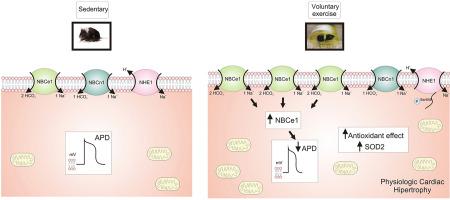Archives of Biochemistry and Biophysics ( IF 3.8 ) Pub Date : 2020-09-29 , DOI: 10.1016/j.abb.2020.108600 Andrés J. Medina , Alejandro M. Ibáñez , Leandro A. Diaz-Zegarra , Enrique L. Portiansky , Paula G. Blanco , Erica V. Pereyra , Verónica C. de Giusti , Ernesto A. Aiello , Alejandra M. Yeves , Irene L. Ennis

|
Physical training stimulates the development of physiologic cardiac hypertrophy (CH), being a key event in this process the inhibition of the Na+/H+ exchanger. However, the role of the sodium bicarbonate cotransporter (NBC) has not been explored yet under this circumstance. C57/Bl6 mice were allowed to voluntary exercise (wheel running) for five weeks. Cardiac mass was evaluated by echocardiography and histomorphometry detecting that training promoted the development of physiological CH (heart weight/tibia length ratio, mg/mm: 6.54 ± 0.20 vs 8.81 ± 0.24; interstitial collagen content, %: 3.14 ± 0.63 vs. 1.57 ± 0.27; and cross-sectional area of cardiomyocytes, μm2: 200.6 ± 8.92 vs. 281.9 ± 24.05; sedentary (Sed) and exercised (Ex) mice, respectively). The activity of the electrogenic isoform of the cardiac NBC (NBCe1) was estimated by recording intracellular pH under high potassium concentration and by measuring action potential duration (APD). NBCe1 activity was significantly increased in isolated cardiomyocytes of trained mice. Additionally, the APD was shorter and the alkalization due to high extracellular potassium-induced depolarization was greater in this group, indicating that the NBCe1 was hyperactive. These results are online with the observed myocardial up-regulation of the NBCe1 (Western Blot, %: 100 ± 13.86 vs. 202 ± 29.98; Sed vs. Ex, n = 6 each group). In addition, we detected a reduction in H2O2 production in the myocardium of trained mice.
These results support that voluntary training induces the development of physiologic CH with up-regulation of the cardiac NBCe1 in mice. Furthermore, the improvement in the antioxidant capacity contributes to the beneficial cardiovascular consequences of physical training.
中文翻译:

NBCe1的心脏上调出现是小鼠自主转轮的有益结果
体育锻炼会刺激生理性心脏肥大(CH)的发展,这是在此过程中抑制Na + / H +交换子的关键事件。然而,在这种情况下,尚未探索碳酸氢钠共转运蛋白(NBC)的作用。C57 / Bl6小鼠被允许自愿锻炼(滚轮跑步)五周。通过超声心动图和组织形态计量学评估心脏质量,发现训练促进了生理性CH的发展(心脏重量/胫骨长度比,mg / mm:6.54±0.20对8.81±0.24;间质胶原含量,%:3.14±0.63对1.57± 0.27;心肌和截面积,微米2:200.6±8.92和281.9±24.05;久坐(Sed)和运动(Ex)小鼠)。通过在高钾浓度下记录细胞内pH值并通过测量动作电位持续时间(APD)来估计心脏NBC(NBCe1)的电异构体的活性。在受过训练的小鼠的离体心肌细胞中,NBCe1活性显着增加。此外,该组中的APD较短,并且由于高细胞外钾诱导的去极化作用而导致的碱化作用较大,表明NBCe1活跃。这些结果与观察到的NBCe1的心肌上调在线相关(Western印迹,%:100±13.86 vs. 202±29.98; Sed vs. Ex,每组n = 6)。此外,我们检测到H 2 O 2的减少 在受过训练的小鼠心肌中产生。
这些结果支持自愿训练通过小鼠心脏NBCe1的上调诱导生理性CH的发展。此外,抗氧化能力的提高有助于体育锻炼有益的心血管后果。











































 京公网安备 11010802027423号
京公网安备 11010802027423号